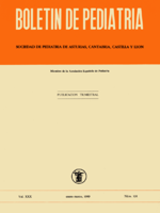Salmonelosis en edad pediátrica: estudio clínico-epidemiológico de un año
M. Gutiérrez , Y. Granja , M. Paradinas , E.J. Muro , F. Fernández de las Heras
Bol. Pediatr. 1989; 30 (131): 33 - 42
Se realizó estudio clínico-epidemiológico de Salmonellosis a lo largo de un año. Se observó una morbilidad alta, representando en nuestro medio la etiología bacteriana más frecuente en las diarreas agudas. Se presentaron más casos en los meses de verano, pero existieron cuadros a lo largo de todo el año. La fiebre fue el síntoma al ingreso más significativo (p<0,05). Existió mayor número de pacientes con talla baja (p<10) en el grupo control de diarreas sin germen enteropatógeno (DSGE) (p <0,025). No se observó incidencia especial de anemia ni leucopenia. Hiponatremia se encontró más frecuentemente (p<0.05) en el grupo de Salmonellosis y urea > 40 mg% con más frecuencia (p<0,025) en el grupo control (DSGE). La Salmonella enteritidis fue el tipo más comúnmente encontrado en el coprocultivo. La estancia media fue significativamente más alta (p<0,005) en la Salmonellosis que en el grupo control.
Salmonellosis in children: clinical and epidemiological study during one year
We have done a clinical and epidemiological study about Salmonella infection (SI) for one year. We have seen a high morbidity in our environment. The Salmonella was the most usual bacterial etiology in the acute diarrhoea. There were more cases in summer but there were patients during all the year. The fever was the most significant symptom at the arriving in hospital (p<0,01). There were more patients with low heigth (p<10) in the control group of diarrhoea without enteropathogenic germs (DWEG) (p <0,025). We did not see special incidence of anaemia or leukopenia. We found hyponatremia more often in the group the SI (P<0,05) and blood urea > 40 mg% was more frequent in control group (DWEG) (p <0,025). Salmonella enteritidis was the most frequently found type. The average stay was significantly
higher (P<0,005) in the SI than in the control group (DWEG).
Artículo completo (PDF) (486 kb.)
- Gastroenterología
